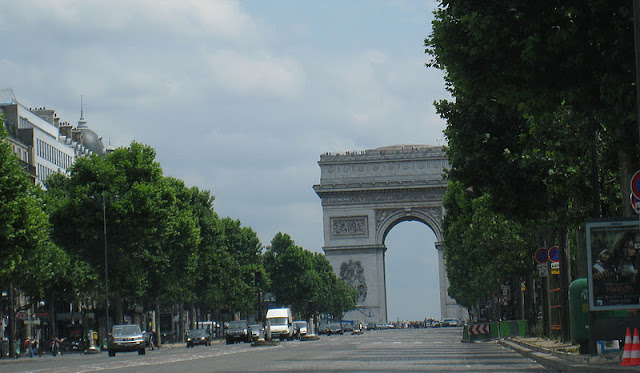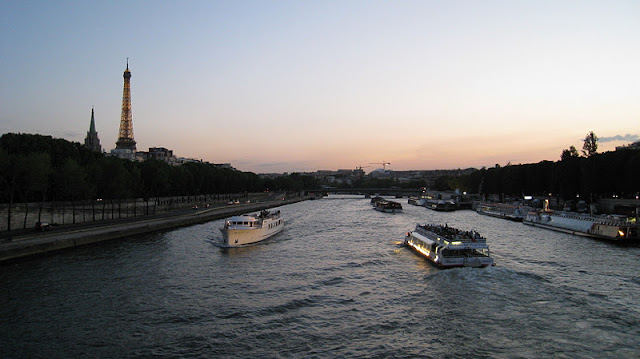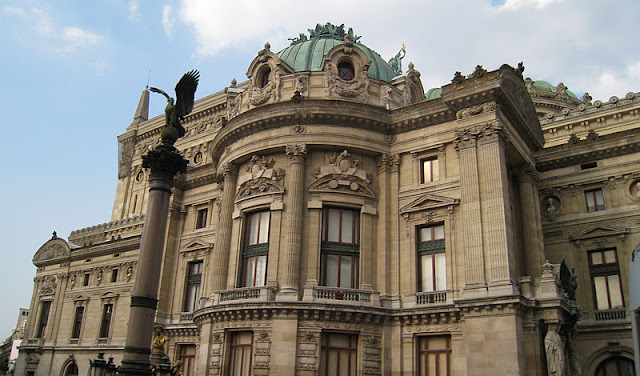Paris, the City of Lights and the capital of France, is one of my favorite vacation destinations in Europe. It has some of the most memorable architectural landmarks and the most fantastic museums on Earth. And of course, French cuisine is out of this world!
And for the young at heart, Paris is the most romantic city in the world!
And for the young at heart, Paris is the most romantic city in the world!
The Eiffel Tower was built for the World Exhibition in 1889, held in celebration of the French Revolution in 1789. The construction was only meant to last for the duration of the Exposition, but it still stands today, despite all protests from contemporary artists who feared the construction would be the advent of structures without 'individuality' and despite the many people who feared that this huge 'object' would not fit into the architecture of Paris.
The man behind the Eiffel Tower was Gustave Eiffel, known from his revolutionary bridge building techniques, as employed in the great viaduct at Garabit in 1884. These techniques would form the basis for the construction of the Eiffel Tower. He was also known for the construction of the Statue of Liberty's iron framework.
The Eiffel Tower (La Tour Eiffel) is the tallest structure in Paris and the iconic landmark of France. Also known locally by its nickname, La Dame de Fer (The Iron Lady), it was the tallest man-made structure in the world for 41 years after completion. It is still one of the greatest engineering marvels in the world.
The Eiffel Tower remains the most recognizable structure and the most visited paid monument in the whole world.
The Arc de Triomphe (Arc de Triomphe de I'Etoile) is one of the most famous monuments in Paris. The Arc was commissioned by Emperor Napoleon Bonaparte to commemorate his great victory at the Battle of Austerlitz against the Austrian Empire.
Looking at the Arc for the first time reminded me of the famous World War II photo showing Nazi troops marching under the Arc while Parisian men openly wept.
The Arc de Triomphe Paris, the most monumental of all triumphal arches, was built between 1806 and 1836. Even though there were many modifications from the original plans, reflecting political changes and power struggles, the Arc still retains the essence of the original concept which was a powerful, unified ensemble.
The Arc de Triomphe stands at the centre of the Place Charles de Gaulle, also known as the Place de l'Étoile. It is located at the western end of the Champs-Élysées. The arches whole decorative style is entirely of the tradition of sculpture from the first half of the nineteenth century.
The triumphal arch is in honor of those who fought for France, in particular, those who fought during the Napoleonic Wars. Engraved on the inside and at the top of the arch are all of the names of the Generals and the various wars they were associated with. There are inscriptions in the ground underneath the vault of the arch which include the Tomb of the Unknown Soldier from World War I where the Memorial Flame burns and have made the Arc de Triomphe Paris a revered patriotic site.
The monument is considered the linchpin of the historic axis (L'Axe historique) — a sequence of monuments and grand thoroughfares on a route which stretches from the courtyard of the Louvre Palace to the outskirts of Paris.
The Czar Alexander III Bridge which spans the seine River in Paris is one of the most beautiful bridges in the world. It is also a marvel of 19th Century engineering. It represented the friendship between the French people and the Russian people. This is an important crossing of the Seine River that connects Pont des Invalides with Pont de la Concorde. Czar Alexander III's son and heir, Czar Nicholas II laid the first foundation stone in 1896. Czar Nicholas II was the last czar of Russia and was overthrown by the Communist Revolution during World War I.
L'Hotel national des Invalides or Les Invalides is a complex of buildings and monuments dedicated to the military history of France as well as a hospital and retirement home for French war veterans. It is the burial site for France's greatest military heroes, including Emperor Napolen Bonaparte.
In 1670, an order for a new building was given which was to be a combination hospital for soldiers and a sort of retirement home for retired soldiers, which was known as a “hôpital des invalides” (hospital for invalids). Construction was completed in 1676, but perhaps the most recognizable feature of Les Invalides today – the gold-capped dome – was added a few years later as a private royal chapel for King Louis XIV. Its design was meant to mimic the dome of St. Peter’s Basilica in Rome, which was designed by Michelangelo, and it was finished in 1708.
In addition to Napoleon’s tomb, the other tombs which are in Les Invalides include Napoleon’s brothers and his son, as well as several Generals who fought alongside him. But visitors to the room where Napoleon is buried probably won’t notice anything but the gigantic sarcophagus in the center. While Napoleon himself is known for his slight stature, the marble tomb containing his body is nothing short of enormous. Your eyes aren’t deceiving you, however, and history’s account of Napoleon being short isn’t mistaken. The outermost layer of the sarcophagus that you see, made of beautiful red porphyry marble, contains six coffins which get progressively smaller until you get to the remains of the man himself.
The Seine River in Paris. One of the most memorable and romantic experience a couple in love can share is a candlelight dinner while cruising the Seine at dusk.
Paris is the capital and the largest city of France, situated on the River Seine. Paris, with a current population of approximately 2.2 Million residents, was the largest city in the Western World for about 1,000 years up to the 19th Century, and the largest city in the whole world between the 16th Century and the 19th Century.
Notre Dame Cathedral
Notre Dame de Paris (Our Lady of Paris) is a Gothic Catholic cathedral in Paris and one of the most famous Catholic cathedrals in the whole world. It is one the first buildings in the world to use the flying butresses architecture. Construction began under the direction of the Bishop of Paris, Maurice de Sully, in 1163. The entire cathdral, which was built in stages, was completed in 1240.
France was one of the earliest countries to progress from feudalism to the nation-state. Its monarchs surrounded themselves with capable ministers, and French armies were among the most innovative, disciplined, and professional of their day. During the reign of Louis XIV (1643-1715), France was the dominant power in Europe. But overly ambitious projects and military campaigns of Louis and his successors led to chronic financial problems in the 18th century. Deteriorating economic conditions and popular resentment against the complicated system of privileges granted the nobility and clerics were among the principal causes of the French Revolution (1789-94). Although the revolutionaries advocated republican and egalitarian principles of government, France reverted to forms of absolute rule or constitutional monarchy four times--the Empire of Napoleon, the Restoration of Louis XVIII, the reign of Louis-Philippe, and the Second Empire of Napoleon III. After the Franco-Prussian War (1870), the Third Republic was established and lasted until the military defeat of 1940.
The Place de la Concorde is the largest public square in the City of Paris. It was originally named Place Louis XV to honor the King of France when it opened in 1755. However, during the French Revolution, the statue of Louis XV was torn down and the public square was renamed Place De La Revolution. The Revolutionary Government erected a guillotine and executed more than 1,300 famous people including King Louis the XVI and Queen Marie Antoinette.
Place De La Concorde Obelisque de Luxor.
At the center of Place De La Concorde stands a giant Egyptian obelisk. It is decorated with Egyptian hieroglyphics honoring Pharaoh Ramses II. The red granite obelisk is 75-foot tall and over 280 tons. This was originally one of the 3,300-year old twin obelisks guarding the entrance to the Temple of Luxor in Egypt. It was given as a gift by Egypt to France in 1829.
The Champs-Élysees is the most prestigious and broadest avenue in Paris. Its full name is actually "Avenue des Champs-Elysees" and the name refers to the Elysian Fields, which is the place of the blessed in Greek mythology. With its cinemas, cafes, and luxury specialty shops, the Champs-Elysees is one of the most famous streets in the world and is very popular with the rich and famous, who travel here just for a day's shopping.
The Champs-Elysees is also known as La Plus Belle Avenue du Monde translated to "The most beautiful avenue in the world".
The avenue runs for 2 kilometres through the 8th arrondissement in the North Western part of Paris. It runs from the Place de la Concorde in the East, with its obelisk, to the Place Charles de Gaulle in the West, which is the location of the Arc de Triomphe.
Paris is not only among the most romantic destinations in the world, it heads the list. Who hasn't dreamed of paying a visit to this marvelous city of love? Romance is in the air as you walk through the largest city of France and become imbued in its rich culture and architecture. This French capital will have you desiring to return again and again. You'll never get enough of Paris. How can one forget the City of Light, Haute Couture, Champagne, Arc de Triomphe and the all-world Mona Lisa?














































































































































No comments:
Post a Comment